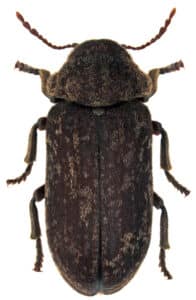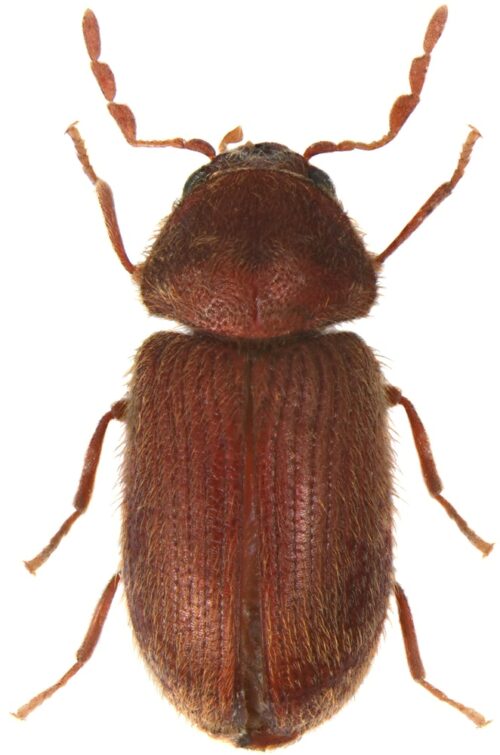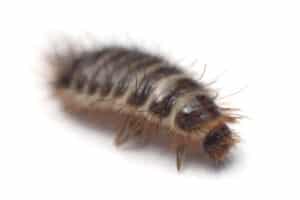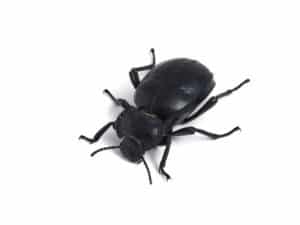Different Types of Beetles & How to Identify Them
By: EarthKind
What do mysterious pinholes in wood flooring, furniture, or trim; damaged carpets and fabric; and discolored or foul smelling flour have in common? These can all be signs of a beetle infestation.
Beetles are a slightly less common household pest, but when they are present in your home, they can be harmful, as they can cause significant damage. Find out about the common types you’re likely to see in your home and how to identify beetles so you can catch a problem before it gets out of control.

Beetle Types
While there are thousands of different types of beetles, only a few are likely to cause trouble inside your house:
- Wood-boring beetles – These pests can be found throughout the United States and are a common type that may find their way into a household. This type is noteworthy because of the damage they cause to furniture, structural and decorative wood in and around homes and other buildings. A few species of wood-boring beetle include:
- Deathwatch beetle.
- False powderpost beetle.
- Powderpost beetle.
- Pantry beetles – These pantry pests are cause for concern because of the damage they cause to stored products and packaged food. They are distributed throughout the United States and are most commonly encountered in warehouses, grocery stores, and home pantries. A few species include:
- Drugstore and cigarette beetle.
- Warehouse beetle.
- Sawtoothed grain beetle and merchant grain beetle.
- Confused flour beetle and red grain flour beetle.
- Carpet beetles – These pests can be found throughout the United States and are noted for the damage they cause to fabrics and upholstered furniture. Homeowners should be aware of and on the lookout for the following species:
- Varied carpet beetle.
- Furniture carpet beetle.
- Black carpet beetle.
- Stink beetles – Unlike the brown marmorated stink bug which is found east of the Mississippi River, stink beetles are typically found in the western United States. They are ‘occasional invaders,’ infrequently wandering into homes and buildings during the summer months. Stink beetles are nuisance pests, but do not pose a threat to people or pets.
When it comes to the damage these pests can do within the home, it’s mostly beetle larvae that cause the destruction. Adult beetles that find their way indoors may lay eggs inside of the house or structure. The larvae will then look for food sources and can cause damage to items including clothing, stored foods, furniture, wood, and more.
Beetle Identification
Beetles are generally identified by their hardened, shell-like bodies which appear to have a line running down their backs. They come in a wide variety of shapes, sizes, and colors. Despite its appearance, a beetle does not, in fact, have a shell. Two hardened wings create the appearance of a shell and cause a line running down the beetle’s back where the wings meet.
You may see the damage these pests are causing before you see the insects themselves, so they can be tricky to identify. Below we go over how to identify beetles and also provide pictures of each type:
- Wood-boring beetles leave behind frass, or the waste they pass, which may look similar to sawdust. They also leave small, round or oval-shaped exit holes where they emerge from wood. This type can range in color anywhere from reddish-brown to black.

- Pantry beetles can cause flour to become discolored, and smell funny. They may also be seen in flour, and have a small tubular appearance. Adults are typically a shade of brown ranging from light to dark.

- Carpet beetles prefer dark, undisturbed places such as the seams of furniture, or underneath rugs and carpets — this makes it very difficult to spot the beetle, or the damage it is causing. Adults typically have a black or brown base color and may also have markings.

- Stink beetles leave an offensive odor on items they come into contact with that may last for weeks. They are darker in color, typically a shade of dark brown or black.

Natural Pest Control and Beetle Prevention
The best way to get rid of these common beetles is to prevent an infestation before it begins. Knowing the signs of an infestation, the damage they can cause, and what they are attracted to will make it easier to prevent the problem.
Some tips include:
- Carefully inspecting new items and their packaging for pests before bringing anything into your home.
- Storing dry goods and pantry items in airtight containers.
- Storing pet food in airtight containers.
- Periodic cleaning and inspection of upholstered furniture.
- Regular home maintenance to seal potential pest entry points.
For extra protection against beetles and other household pests, a botanical repellent like Stay Away® can be used to create an invisible barrier that beetles and bugs will not cross. The scent of essential oils in Stay Away obscures any appealing aromas of food or scent trails insects may follow into your home without the use of harmful chemicals.






I found a beetle looking bug between my cats shoulderblades. It was protruding almost above his fur. I reached out to take it off and it was more resistant than I thought it would be. I was able to eventually remove it although it looked like something was left behind below the furline.
I saved the bug. Its the color army green. It is oval in shape, 1/2″ long and 3/8″ wide. it has three legs on each side of the body. Two antennae in front. The surface of the beetle feels somewhat pliable with three enlongated linear depression almost like an imprint of the letter X across its back.
Any help would be most welcome. Thank you.
Hi Richard,
That sounds very unusual! I would suggest following up with your vet to make sure nothing was left behind. If the vet is unable to offer any help identifying the insect, you could try checking your local Ag Extension office – they will be more familiar with insects commonly found in your region.
Thanks for reading!
Do you know if this product has an affect on squash bugs? My entire house is covered outside and being overtaken inside! 😛
Hi Katherine,
Stay Away Beetles hasn’t been tested on squash bugs, so we can’t say for certain, but they do seem similar to the types of bugs that are repelled by Stay Away. If you give it a try, please let us know how it works for you. The Farmer’s Almanac also has some helpful info for getting rid of squash bugs, although it is mostly focused on garden tips. For the outside of your home, we would suggest spray washing with soapy water to remove any bugs that are hanging around.
Thanks for reading!
Pictures of types of beetles would be helpful
Hi Teresa,
Pictures are most helpful, you’re right! Here’s a great resource: https://www.insectidentification.org/beetles.asp
Thanks for reading!
Our area (central Wisconsin) seems to have a terrible time with Asian beetles…those pesky things that look like lady beetles but swarm heavily in the late summer and early fall. They swarm about the time soybean fields are cut, looking for a place to hibernate for winter. They will cling to the south sides of most buildings and the east then west as the sun moves during the day warming those sides. Many of us with older homes are subject to large numbers of them finding their way into our homes, even after extensive exterior remodeling that includes windows, doors and siding, is done. They leave horrible stains when they are crushed against anything, and give off a very offensive odor. They have no known predator. Does EarthKind have anything that can be safely used to deter the invasion?
Try placing pouches of Stay Away Beetles in the areas where you are finding pests. Thanks for reading!